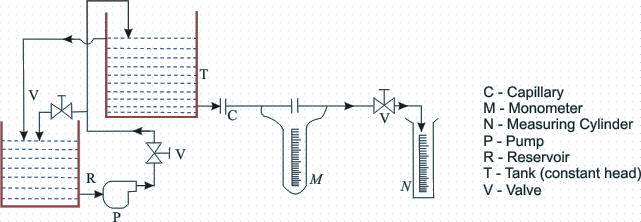|
Applications-
- Equation (26.8) is commonly used in the measurement of viscosity with the help of capillary tube viscometers . Such a viscometer consists of a constant head tank to supply liquid to a capillary tube (Fig. 26.4).

FIG 26.4 Schematic diagram of the experimental facility for determination of viscosity
- Pressure drop readings across a specified length in the developed region of the flow are taken with the help of a manometer. The developed flow region is ensured by providing the necessary and sufficient entry length.
- From Eq. (26.8), the expression for viscosity can be written as
- The volumetric flow rates (Q) are measured by collecting the liquid in a measuring cylinder. The diameter (D) of the capillary tube is known beforehand. Now the viscosity of a flowing fluid can easily be evaluated.
- Shear stress profile across the cross-section can also be determined from this information. Shear stress at any point of the pipe flow is given by
This also indicates that  varies linearly with the radial distance from the axis. varies linearly with the radial distance from the axis.
- At the wall,
 assumes the maximum value. assumes the maximum value.
Again, over a pipe length of l , the total shear force is
or
or
 [Pressure drop between the specified length] [Pressure drop between the specified length] |
|
as it should be. Negative sign indicates that the force is acting in opposite to the flow direction.
- However, from Eq. (26.6b), we can write
 |
(26.9c) |
or  |
(26.10)
|
|